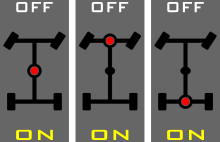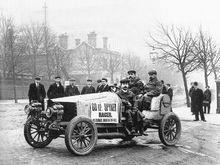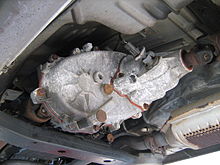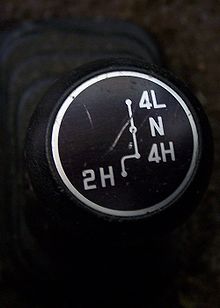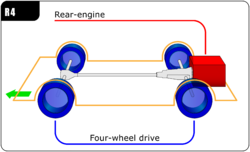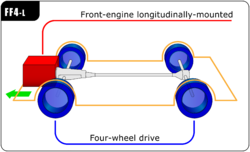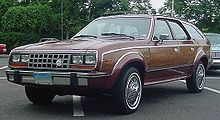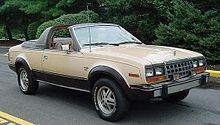- Four-wheel drive
-
This article is about the class of vehicle drivetrains. For other uses, see Four by four/Four-wheel drive (disambiguation)."All-wheel drive" redirects here. For the all-wheel drive in motorcycles, see two-wheel drive.
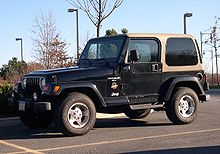 The Jeep Wrangler is a 4WD vehicle with a transfer case to select low range or high range 4WD.
The Jeep Wrangler is a 4WD vehicle with a transfer case to select low range or high range 4WD.
Four-wheel drive, 4WD, or 4×4 ("four by four") is a four-wheeled vehicle with a drivetrain that allows all four wheels to receive torque from the engine simultaneously. While many people associate the term with off-road vehicles and Sport utility vehicles, powering all four wheels provides better control than normal road cars on many surfaces, and is an important part in the sport of rallying.
In abbreviations such as 4×4, the first figure is normally taken as the total number of wheels and the second is normally taken as the number of powered wheels (the numbers are actually axle-ends to allow for more than one wheel on each end of an axle). 4×2 means a four-wheel vehicle in which engine power is transmitted to only two axle-ends: the front two in front-wheel drive or the rear two in rear-wheel drive.[1] Side-wheel drive and diagonal-wheel drive is as of this point in time merely a concept, and is yet to be developed.
Contents
Drive arrangements
Most 4WD/AWD fall into four categories:
- F4: Front-engine, rear-wheel drive derived 4WD/AWD layout
- R4: Rear-engine / All-wheel drive system (AWD)
- FF4–T: Front-engine transversely-mounted / front-wheel drive derived AWD layout
- FF4–L: Front-engine longitudinally-mounted / front-wheel drive derived AWD layout
4WD versus AWD
The term four-wheel drive typically describes larger passenger vehicles that may allow the driver to manually switch (sometimes with an automatic option) between two-wheel drive mode (if available) for streets and four-wheel drive mode for low-traction conditions such as ice, mud, snow, or loose gravel.
All-wheel drive (AWD) is often used to describe a "full time" 4WD that may be used on dry pavement without damaging the differentials, although the term may be abused when marketing a vehicle[2][non-primary source needed] as there are no specific definitions or guidelines (per the SAE for example) to differentiate these terms.[3] AWD can be used on dry pavement because it employs a center differential, which allows each axle to rotate at a different speed. This eliminates driveline binding, wheel hop, and other driveline issues associated with the use of 4WD on dry pavement. For vehicles with more than four wheels, AWD means all wheels drive the vehicle, to varying degrees of engagement, while 4WD means only four of the wheels drive the vehicle continuously. For example, an AWD vehicle with six wheels is often described as a 6×6, the M35 2½ ton cargo truck being one of the best-known examples (dual wheels on the rear axles are not counted as additional drive wheels).
Because all 4 tires in a full time AWD system are connected by a system of differentials, they are potentially very susceptible to torque reduction when a wheel loses traction. Without sophisticated traction control systems, they would become immobilized when any one of the four tires lost traction. A traditional part time 4WD system does not connect the front and rear via a differential, and therefore does not suffer any front/rear torque reduction—if a front tire loses traction, it does not reduce torque delivered to the rear tires, even without traction control systems.
Part-time 4WD systems are mechanically simpler and cheaper than AWD systems. Also, a part-time 4WD transfer case is usually equipped with a reduction gear setting that provides for higher torque at lower speeds, a vital feature for vehicles that will see much off-road use. In AWD systems a more expensive separate reduction gearbox is usually used. The main drawback of 4WD is that because it lacks a center differential, a part-time 4WD system can only be used in low traction situations where the wheels have the ability to slip as needed.
For these reasons, full-time AWD is appropriate for improving on-road handling and is seen on cars and car-based crossover SUVs, while traditional part-time 4WD systems without center differentials, or with locking center differentials, are better for heavy-duty use such as off-road or in deep snow and are commonly seen on trucks and truck-based SUVs.
Manufacturers often use these terms interchangeably, and the English word all is obviously equivalent to the word four when referring to a set of four wheels. In typical use, the terms are used as described above, but they are not fixed or legal definitions, and some manufacturers, such as Honda, often use the term "four wheel drive" when referring to systems that include center differentials. These terms are therefore not always very reliable for assessing the features and capabilities of a given drivetrain.
Identical drivetrain systems are commonly marketed under different names for upmarket and downmarket branding and, conversely, different drivetrain systems are commonly marketed under the same name for brand uniformity. Audi's quattro, Mercedes-Benz's 4Matic, BMW with the xDrive, Saab's XWD, and Volkswagen's 4motion, for example, can mean either an automatically engaging "on-demand" system with Borg-Warner ITM 3e magnetic or Haldex Traction hydraulic clutch, or a continuously-operating permanent 4WD system with a Torsen (torque-sensing) or other type of a differential.
4WD versus IWD
The term Individual-wheel drive is coined to identify those electric vehicles whereby each wheel is driven by its own individual electric motor. This system essentially has inherent characteristics that would be generally attributed to Four-Wheel drive systems like the distribution of the available power to the wheels. The IWD drive is not limited to 4 wheels as there is generally a motor that drives each wheel that can number upwards of 4, but could also identify a single wheeled vehicle.
Design
Differentials
The Lamborghini Murciélago is an AWD that powers the front via a viscous coupling unit if the rear slips.
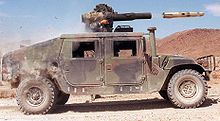 The HMMWV is a 4WD/AWD that powers all wheels evenly (continuously) via a manually lockable center differential, with Torsen differentials for both front and rear.
The HMMWV is a 4WD/AWD that powers all wheels evenly (continuously) via a manually lockable center differential, with Torsen differentials for both front and rear.
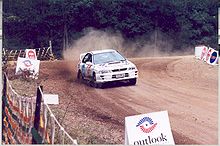 A Subaru Impreza rally car uses AWD for traction.
A Subaru Impreza rally car uses AWD for traction.
When powering two wheels simultaneously the wheels must be allowed to rotate at different speeds as the vehicle goes around curves. The problem is even more complicated when driving all four wheels. A design that fails to account for this will cause the vehicle to handle poorly on turns, fighting the driver as the tires slip and skid from the mismatched speeds.
A differential allows one input shaft to drive two output shafts independently with different speeds. The differential distributes torque (angular force) evenly, while distributing angular velocity (turning speed) such that the average for the two output shafts is equal to that of the differential ring gear. Each powered axle requires a differential to distribute power between the left and the right sides. When all four wheels are driven, a third differential can be used to distribute power between the front and the rear axles.
The described system handles extremely well, as it is able to accommodate various forces of movement, and distribute power evenly and smoothly; making slippage unlikely. Once it does slip, however, recovery is difficult. If the left front wheel of a 4WD vehicle slips on an icy patch of road, for instance, the slipping wheel will spin faster than the other wheels due to the lower traction at that wheel. Although the amount of torque applied to each wheel will be identical, the amount of traction at each driven wheel will be limited to that of the wheel with the least traction (at least one wheel on ice in this case). This problem can happen in both 2WD and 4WD vehicles, whenever a driven wheel is placed on a surface with little traction or raised off the ground. The simplistic design works acceptably well for 2WD vehicles. It is much less acceptable for 4WD vehicles because 4WD vehicles have twice as many wheels to lose traction, increasing the likelihood that it will happen. 4WD vehicles may also be more likely to be driven on surfaces with reduced traction.
Limiting slippage
Traction control was invented to solve this problem for 2WD vehicles. When one wheel spins out of control the brake is automatically applied to that wheel. By preventing one wheel from spinning freely, power is divided between the pavement for the non-slipping wheel and the brake for the slipping wheel. This is an effective solution, although it causes additional brake wear and may cause a sudden jolt that affects handling. By extending traction control to act on all four wheels the simple three-differential 4WD design will see limited wheel spin. This design is commonly seen on luxury crossover SUVs.
Locking differentials work by temporarily locking together a differential's output shafts, causing all wheels to turn at the same rate, providing torque in case of slippage. This is generally used for the center differential, which distributes power between the front and the rear axles. While a drivetrain that turns all wheels equally would normally fight the driver and cause handling problems, this is not a concern when wheels are slipping.
The two most common factory-installed locking differentials use either a computer-controlled multi-plate clutch or viscous coupling unit to join the shafts, while other differentials more commonly used on off-road vehicles generally use manually operated locking devices. In the multi-plate clutch the vehicle's computer senses slippage and locks the shafts, causing a small jolt when it activates, which can disturb the driver or cause additional traction loss. In the viscous coupling differentials the shear stress of high shaft speed differences causes a dilatant fluid in the differential to become solid, linking the two shafts. This design suffers from fluid degradation with age and from exponential locking behavior. Some designs use gearing to create a small rotational difference which hastens torque transfer.
A third approach to limiting slippage is the Torsen differential. A Torsen differential allows the output shafts to receive different amounts of torque. This design does not provide for traction when one wheel is spinning freely, where there is no torque. It provides excellent handling in less extreme situations. A typical Torsen II differential can deliver up to twice as much torque to the high traction side before traction is exceeded at the lower tractive side.
Finally, many lower-cost vehicles entirely eliminate the center differential. These vehicles behave as 2WD vehicles under normal conditions. When the drive wheels begin to slip, one of the locking mechanisms discussed above will join the front and rear axles. Such systems distribute power unevenly under normal conditions and thus do not help prevent the loss of traction, instead only enabling recovery once traction is lost. Most minivan 4WD/AWD systems are of this type, usually with the front wheels powered during normal driving conditions and the rear wheels served via a viscous coupling unit. Such systems may be described as having a 95/5 or 90/10 power split.[according to whom?]
History
In 1893, before the establishment of a modern automotive industry in Britain, English engineer Bramah Joseph Diplock patented a four wheel drive system for a traction engine, including four-wheel steering and three differentials, which was subsequently built. The development also incorporated Bramah's Pedrail wheel system in what was one of the first four-wheel drive automobiles to display an intentional ability to travel on challenging road surfaces. It stemmed from Bramagh's previous idea of developing an engine that would reduce the amount of damage to public roads.
Ferdinand Porsche designed and built a four-wheel driven Electric vehicle for the k. u. k. Hofwagenfabrik Ludwig Lohner & Co. at Vienna in 1899, presented to the public during the 1900 World Exhibition at Paris. An electric hub motor at each wheel powered the vehicle. Although clumsily heavy, the vehicle proved a powerful sprinter and record-breaker in the hands of its owner E.W. Hart. Due to its unusual status the so-called Lohner-Porsche is not widely credited as the first four-wheel driven automobile.
The first four-wheel drive car, as well as hill-climb racer, with internal combustion engine, the Spyker 60 H.P., was presented in 1903 by Dutch brothers Jacobus and Hendrik-Jan Spijker of Amsterdam.[4][5] The two-seat sports car, which was also the first ever car equipped with a six-cylinder engine, is now an exhibit in the Louwman Collection (the former Nationaal Automobiel Museum) at the Hague in The Netherlands.
Designs for four-wheel drive in the U.S., came from the Twyford Company of Brookville, Pennsylvania in 1905, six were made there around 1906; one still exists and is displayed annually.[6] The second U.S. four-wheel drive vehicle was built in 1908 by (what became) the Four Wheel Drive Auto Company (FWD) of Wisconsin (not to be confused with the term "FWD" as an acronym for front-wheel drive). FWD would later produce around 15,000 of its four-wheel drive Model B trucks for the British and American armies during World War I.[7] Approximately 11,500 of the Jeffery or Nash Quad models (1913–1919) were similarly used. The Quad not only came with four-wheel drive and four-wheel brakes, but also featured four-wheel steering.[7]
The Reynolds-Alberta Museum has a four-wheel drive "Michigan" car from about 1905 in unrestored storage. The Marmon-Herrington Company was founded in 1931 to serve a growing market for moderately priced four-wheel drive vehicles. Marmon-Herrington specialized in converting Ford trucks to four wheel drive and got off to a successful start by procuring contracts for military aircraft refueling trucks, 4×4 chassis for towing light weaponryJimmy Nylund. "27 Trailer Towing Tips". http://www.fourwheeler.com/techarticles/129_0607_trailer_towing/index.html. Retrieved February, 2009., commercial aircraft refueling trucks, and an order from the Iraqi Pipeline Company for what were the largest trucks ever built at the time.
Daimler-Benz also has a history in four-wheel drive. In 1907 the Daimler Motoren Gesellschaft had built a four-wheel driven vehicle called Dernburg-Wagen, also equipped with four-wheel steering, that was used by German colonial civil servant, Bernhard Dernburg, in Namibia. Mercedes and BMW, in 1926, introduced a rather sophisticated four-wheel drive, the G1, the G4 and G4 following. The 1937 Mercedes-Benz G5 and BMW 325 4×4 featured full time four-wheel drive, four-wheel steering, three locking differentials, and fully independent suspension. They were produced because of a government demand for a four-wheel drive passenger vehicle. The modern G-series/Wolf such as the G500 and G55 AMG still feature some of the attributes, with the exception of fully independent suspension since it hinders suspension articulation. The Unimog is another Mercedes truck.
It was not until "go-anywhere" vehicles were needed for the military that four-wheel drive found its place. The Jeep, originally developed by American Bantam but mass-produced by Willys and Ford, became the best-known four-wheel drive vehicle in the world during World War II. Willys (since 1950 owner of the Jeep name) introduced the CJ-2A in 1945 as the first full-production four-wheel drive passenger vehicle. Possibly beaten by the 1938 GAZ-61.
The Land Rover appeared at the Amsterdam Motor Show in 1948, originally conceived as a stop-gap product for the struggling Rover car company, and despite chronic under-investment succeeded far better than the passenger cars. Land Rover developed a luxury 4WD with the Range Rover in the 1970s, which, unlike some offerings from other manufacturers, was capable of serious off-road use. The inspiration was a Willys MB that was frequently run off-road on the farm belonging to chief engineer Maurice Wilks, and was felt that it needed some refinement.
Kaiser Jeep, the successor to Willys, introduced a 4WD wagon called the Wagoneer in 1963. It was revolutionary at the time, not only because of its technical innovations such as an independent front suspension and the first automatic transmission with 4WD, but also because it was equipped and finished as a regular passenger automobile.[8] The Super Wagoneer (1966 to 1969) was powered by Rambler or Buick V8s. Its high level of equipment made it the first "luxury" SUV. American Motors (AMC) acquired Kaiser's Jeep Division in 1970 and quickly upgraded and expanded the entire line of serious off-road 4WD vehicles. The top range full-size Grand Wagoneer continued to compete with traditional luxury cars.[9] It was relatively unchanged during its production through 1991, even after Chrysler's buyout of AMC.
Jensen applied the Formula Ferguson (FF) full-time all-wheel drive system to 318 units of their Jensen FF built from 1966 to 1971, marking the first time 4WD was used in a production GT sports car.[10] While most 4WD systems split torque evenly, the Jensen split torque roughly 40% front, 60% rear by gearing the front and rear at different ratios. Subaru introduced the mass-produced Leone in 1972 featuring a part-time four-wheel drive system that could not be engaged on dry pavement. The American Motors Company introduced a full time AWD vehicle the same year as the Subaru in the Jeep Cherokee and Wagoneer with Quadra Trac (1973 model year first models sold in Sept 1972).[11] It dominated all other makes in FIA rally competition, due to the performance of the full time AWD, which did not require the driver to get out of the vehicle to lock hubs or manually select between 2WD and 4WD modes in the car like other American 4-wheel drive vehicles of the period. Drivers Gene Henderson and Ken Pogue won the Press-on-Regardless Rally FIA championship with a Quadra Trac equipped Jeep in 1972.[12]
American Motors introduced the innovative Eagle for the 1980 model year.[13] These were the first mass production cars to use the complete FF system.[14] The AMC Eagle was the world's first complete line (sedan, coupe, and station wagon) of permanent automatic all-wheel drive passenger models. The new Eagles combined Jeep technology with an existing and proven AMC passenger automobile platform. They ushered a whole new product category of "sport-utility" or crossover SUV. AMC's Eagles came with the comfort and high-level appointments expected of regular passenger models and used the off-road technology for an extra margin of safety and traction.[15]
The Eagle's thick viscous fluid center differential provided quiet and smooth transfer of power that was directed proportionally to the axle with the greatest traction. This was a true full-time system operating only in four-wheel drive without undue wear on suspension or driveline components. There was no low range in the transfer case. This became the forerunner of the designs that followed from other manufacturers.[16] The automobile press at the time tested the traction of the Eagles and described it as far superior to the Subaru's and that it could beat many so-called off-road vehicles. Four Wheeler magazine concluded that the AMC Eagle was "The beginning of a new generation of cars."[17]
The Eagles were popular (particularly in the snowbelt), had towing capacity, and came in several equipment levels including sport and luxury trims. Two additional models were added in 1981, the sub-compact SX/4 and Kammback. A manual transmission and a front axle-disconnect feature were also made available for greater fuel economy. During 1981 and 1982 a unique convertible was added to the line. The Eagle's monocoque body was reinforced for the conversion and had a steel targa bar with a removable fiberglass roof section.[18] The Eagle station wagon remained in production for one model year after Chrysler acquired AMC in 1987.
Audi also introduced a permanently all-wheel driven road-going car, the Audi Quattro, in 1980. Audi's chassis engineer, Jorg Bensinger, had noticed in winter tests in Scandinavia that a vehicle used by the German Army, the Volkswagen Iltis, could beat any high-performance Audi. He proposed developing a four-wheel drive car, that would also used for rallying to improve Audi's conservative image. The Audi Quattro system was successful and became a feature on production cars.
In 1987, Toyota also developed a car built for competition in rally campaigns.[19] A limited number of road-going FIA Homologation Special Vehicle Celica GT-Fours (otherwise known as Toyota Celica All-Trac Turbo in some markets) were produced. The All-Trac system was later available on serial production Toyota Camry, Toyota Corolla, and Toyota Previa models.
Some of the earliest mid-engined four-wheel drive cars were the various road-legal rally cars made for Group B homologation, such as the Ford RS200 made from 1984 to 1986. In 1989, niche maker Panther Westwinds created a mid-engined four-wheel drive, the Panther Solo 2.
In 2008, Nissan introduced the GT-R featuring a rear mounted transaxle. The AWD system requires two drive shafts, one main shaft from the engine to the transaxle and differential and a second drive shaft from the tranasaxle to the front wheels.[20]
The Ferrari FF introduced in 2011 features a unique system called 4RM, which does away with the heavy center differential and instead attaches a smaller, second transaxle that draws power from the front of the engine. This allows the car to keep the traditional rear transaxle design without the need for a second driveshaft for the front wheels.
Today, sophisticated all-wheel drive systems are found in many passenger vehicles and some exotic sports cars and supercars. Mainstream luxury and near-luxury vehicles which can absorb the extra cost involved, and for which the fuel economy penalty of some 5% is not an issue, are offered with AWD (or "4x4" or "4WD") as a safety enhancement to meet owners' expectations for a full complement of up-to-date technology.[21]
Road racing
Spyker is credited with building and racing the first ever four-wheel racing car, the Spyker 60 HP in 1903.[4][5]
Bugatti created a total of three four-wheel drive racers, the Type 53, in 1932, but the cars were notorious for having poor handling.
Ferguson Research Ltd. built the front-engine P99 Formula One car that actually won a non-World Championship race with Stirling Moss in 1961. In 1969, Team Lotus raced cars in the Indy 500 and two years later in Formula 1 with the Lotus 56, that had both turbine engines and 4WD, as well as the 4WD-Lotus 63 that had the standard 3-litre V8 Ford Cosworth engine. Matra also raced a similar MS84, and McLaren entered their M9A in the British Grand Prix, while engine manufacturers Ford-Cosworth produced their own version which was tested but never raced. All these F1 cars were considered inferior to their RWD counterparts, as the advent of aerodynamic downforce meant that adequate traction could be obtained in a lighter and more mechanically efficient manner, and the idea was discontinued, even though Lotus tried repeatedly.
Nissan and Audi had success with all-wheel drive in road racing with the former's advent of the Nissan Skyline GT-R in 1989. So successful was the car that it dominated the Japanese circuit for the first years of production, going on to bigger and more impressive wins in Australia before weight penalties eventually levied a de facto ban on the car. Most controversially was the win pulled off at the 1990 Macau Grand Prix where the car led from start to finish. Audi's dominance in the Trans-Am Series in 1988 was equally controversial as it led to a weight penalty mid season and to a rule revision banning all-AWD cars, its dominance in Supertouring eventually led to a FIA ban on AWD system in 1998.
New 2011 24 Hours of Le Mans regulations may revive AWD/4WD in road racing, though such systems are only allowed in new hybrid-powered Le Mans Prototypes.[22]
In construction equipment
A Case loader–backhoe equipped with 4WD (note the 4×4 designation on the battery box, the difference in design of the front hubs, and the treaded front tires).
During the late 1980s, there was a movement by construction equipment builders to find a way for their equipment to handle any terrain they can drive across. The first to utilize a 4WD system was Case Corporation (then known as J.I. Case Co.), who designed a hearty four-wheel drive system that was instantly tested, and placed on several models of their Loader/Backhoe line. This system was first used in 1987, and has become somewhat of a benchmark in construction equipment. Today, several construction equipment manufacturers offer a 4WD system as an option on their equipment, mostly backhoes.
The 4WD systems on construction equipment are much stronger and larger than their automobile counterparts, incorporating several redundancies in their design, it is also equipped with an external method of lubricating the gears inside of the transfer case, and the front differential, which are both monitored in the cab by temperature gauges, this is to primarily prevent overheating, and welding of the gears in the transfer case.
The change in outer appearance of a loader–backhoe equipped with 4WD is instantly noticeable, mostly in the difference of the front hubs, which are flat in design, instead of having the standard rear drive appearance, with the large cone protruding from the rims. The second noticeable difference is the design of the front tires, which have a tread on them similar to that of the rear tires, but in smaller scale. The final difference is usually the designation "4×4", placed somewhere noticeable, usually on either the battery box or the rear fenders.
Terminology
Although in the strictest sense, the term "four-wheel drive" refers to a capability that a vehicle may have, it is also used to denote the entire vehicle itself. In Australia, vehicles without significant off-road capabilities are often referred to as All-Wheel Drives (AWD) or SUVs, while those with off-road capabilities are referred to as "four-wheel drives". This term is sometimes also used in North America, somewhat interchangeably for SUVs and pickup trucks and is sometimes erroneously applied to two-wheel-drive variants of these vehicles.
The term 4×4 (read: four by four) was in use to describe North American military four-wheel-drive vehicles as early as the 1940s,[23] with the first number indicating the total number of wheels on a vehicle and the second indicating the number of driven wheels. This remained essentially a military term until the following decade when it entered the lexicon of North American car enthusiasts as a colloquialism for the relatively unusual combination of a 4-speed transmission floor-shifter known colloquially as "Four on the Floor", when 3-speed column-shifters ("Three on the Tree") were prevalent, along with a 4-wheel drive system. Today, the term 4×4 is common in North America, and is generally used when marketing a new or used vehicle, and is sometimes applied as badging on a vehicle equipped with four-wheel drive. Similarly, a 4×2 would be appropriate for most two-wheel-drive vehicles, and is often used to describe them as a two-wheel drive. In Australia the term is often used to describe a ute that sits very high on its suspension. This is to avoid the confusion that the vehicle might be a 4×4 because it appears to be otherwise suited to off-road applications.
Large American trucks with dual tires on the rear axles and two driven axles are officially designated as 4×4s, despite having six driven wheels, because the "dual" wheels behave as a single wheel for traction and classification purposes, and are not individually powered. True six-wheel drive vehicles with three powered axles such as the famous "deuce and a half" truck used by the U.S. Army has three axles (two rear, one front), all of them driven. This vehicle is a true 6×6, as is the Pinzgauer, which is popular with defense forces around the globe.
Another related term is 4-wheeler (or four-wheeler). This generally refers to all-terrain vehicles with four wheels, and does not indicate the number of driven wheels; a "four wheeler" may have two or four-wheel drive. (In CB slang, truckers refer to any two-axled vehicle as a "four-wheeler", sometimes in a derogatory sense, as distinguished from an "eighteen-wheeler" or tractor/trailer.)
Unusual systems
Prompted by a perceived need for a simple, inexpensive all-terrain vehicle for oil exploration in North Africa, the French motor manufacturer Citroën developed the 2CV Sahara. Unlike other 4×4 vehicles which use a conventional transfer case to drive the front and rear axle, the Sahara had two engines, each independently driving a separate axle, with the rear engine facing backwards. The two throttles, clutches and gear change mechanisms could be linked, so both 12 hp (9 kW) 425 cc (26 cu in) engines could run together, or they could be split and the car driven solely by either engine. Combined with twin fuel tanks and twin batteries (which could be set up to run either or both engines), the redundancy of two separate drive trains meant that they could make it back to civilization even after major mechanical failures. Only around 700 of these cars were built, and only 27 are known to exist today.[24] Enthusiasts have built their own "new" Saharas, by rebuilding a 2CV and fitting the modified engine, gearbox and axle onto a new, strengthened chassis.
BMC experimented with a twin-engine Mini Moke (dubbed the "Twini Moke") in the mid-1960s, but never put it into production. This made advantage of the Mini's 'power pack' layout, with a transverse engine and the gearbox in the engine sump. Simply by fitting a second engine/gearbox unit across the rear, a rudimentary 4×4 system could be produced. Early prototypes had separate gear levers and clutch systems for each engine. Later versions sent for evaluation by the British Army had more user-friendly linked systems.
In 1965, A. J. M. Chadwick, patented, GB 1113068, a 4WD system that used hemispherical wheels for an all-terrain vehicle. Twenty years later, B. T. E. Warne, patented, GB 2172558, an improvement on Chadwick's design that did not use differential gear assemblies. By using near-spherical wheels with provision to tilt and turn each wheel co-ordinatively, the driven wheels maintain constant traction. Furthermore, all driven wheels steer and, as pairing of wheels is not necessary, vehicles with an odd number of wheels are possible without affecting the system's integrity. Progressive deceleration is made possible by dynamically changing the front-to-rear effective wheel diameter ratios.
Suzuki Motors introduced the Suzuki Escudo Pikes Peak Edition in 1996. Earlier Suzuki versions were twin engined, from 1996 on the engine is a twin-turbocharged 2.0 L V6, mated to a sequential 6-speed manual transmission.
Nissan Motors has developed a system called E4WD, wherein the rear wheels, in a car that is normally front-wheel drive, are driven by electric motors. This system was introduced in some variants of the Nissan Cube and Tiida. (This is similar to the system used on the Ford Escape Hybrid AWD.[25])
Chrysler's Jeep Division debuted the twin engine, 670 hp (500 kW) Jeep Hurricane concept at the 2005 North American International Auto Show in Detroit. This vehicle has a unique "crab crawl" capability, which allows it to rotate 360° in place. This is accomplished by driving the left wheels as a pair and right wheels as a pair, as opposed to driving the front and rear pairs. A central gearbox allows one side to drive in the opposite direction to the other. It also has dual Hemi V8s.
Some hybrid vehicles such as the Lexus RX400h provide power to an AWD system through a pair of electric motors, one to the front wheels and one to the rear. In the case of the AWD model version of the Lexus RX400h (and its Toyota-branded counterpart, the Harrier hybrid), the front wheels can also receive drive power directly from the vehicle's gasoline engine as well as via the electric motors, whereas the rear wheels derive power only from the second electric motor. Transfer of power is managed automatically by internal electronics based on traction conditions and need, making this an all-wheel drive system.
The 4RM system used in the Ferrari FF is unique in that it uses two gearboxes, in addition to the traditional Ferrari rear transaxle behind the engine, the system also uses a smaller transaxle drawing power from the front of the engine, sending it to the front wheels as needed. The system usually operates in the rear-drive only mode and only engages the clutches for the front transaxle when the rear wheels start losing grip.
Introduction to off-roaders
Year Manufacturer Model/Series Mass Small series 1933 Mitsubishi Motors Mitsubishi PX33 x 1941 GAZ GAZ-64 Military 1941 Willys-Overland Willys MA/MB Military 1941 Volkswagen Typ 128 Schwimmwagen Military 1946 Dodge Power Wagon Military 1948 Ford Ford F-series x 1948 Rover Land Rover Series x 1951 Alfa Romeo Alfa Romeo Matta Military 1951 Austin Motor Company Austin Champ Military 1951 Fiat Fiat Campagnola Military 1951 Nissan Nissan Patrol x 1954 Toyota Land Cruiser x 1956 Auto Union DKW Munga Military 1968 Suzuki Lj10 x 1970 British Leyland Range Rover x 1972 UAZ UAZ-469 Military 1976 Lada Lada Niva x 1979 Mercedes-Benz
Steyr-Daimler-PuchG-Modell x Introduction to passenger cars
Year Manufacturer Model/Series Mass Small series 1966 Jensen Jensen FF x (320 units) 1972 Subaru Subaru Leone x 1980 American Motors AMC Eagle x 1980 Audi Audi Quattro x 1982 Renault Renault 18 Combi 4×4 x 1984 Alfa Romeo Alfa 33 4×4 x 1984 Mitsubishi Mitsubishi Cordia 4WD Turbo x 1984 Volkswagen Volkswagen Passat Syncro x 1984 Peugeot Peugeot 205 T16 x (200 units) 1985 BMW BMW 325iX x 1985 Lancia Lancia Delta HF 4WD x 1985 Mazda Mazda 323 4WD x 1986 Toyota Toyota Celica GT-Four All-Trac Turbo x 1986 Ford Ford RS200 x (220 units) 1987 Mercedes-Benz Mercedes W124 4MATIC x 1987 Porsche Porsche 959 x (292 units) 1988 Opel Opel Vectra 4×4 x 1989 Citroën Citroën BX x 1990 Chevrolet Chevrolet Astro Full time AWD x 1991 Lamborghini Lamborghini Diablo VT x 1991 Bugatti Bugatti EB110 x (ca. 300 units) 1992 Fiat Tempra 4×4 x 1997 Volvo 850 AWD x 2001 Jaguar Jaguar X-Type x 2008 Saab Saab 9-3 Turbo X x 2010 Dacia Dacia Duster x 2011 Ferrari Ferrari FF x Systems by design type
Center differential with mechanical lock
- Alfa Romeo 164 Q4 (central viscous coupling, epicyclic unit and Torsen rear differential)
- Alfa Romeo 155 Q4 (central epicyclic unit, Ferguson viscous coupling and Torsen rear differential)
- AMC Eagle (central viscous coupling)
- Audi - Quattro Coupé, 80, 90, 100 & 200 (locking center and rear differentials) - up to 1987
- Audi Q7 -double pinion 50/50 with lockup clutch pack
- BMW 3 series and 5 series in the 1980s - planetary center differential with a 37-63 (front-back) torque split and viscous lock (also in rear differential but not front differential)
- Ford - Escort (RS 2000 16v 4×4 models and RS Cosworth), Sierra Cosworth, Sierra and Granada 4×4 models,
- Ford Explorer (1995–2010) - BorgWarner ControlTrac with two-speed transfer case and infinitely variable center multi-plate clutch differential
- Ford Expedition (1997–present) and Expedition EL/Max (2007–present) - BorgWarner ControlTrac with two-speed transfer case and infinitely variable center multi-plate clutch differential
- Mercedes-Benz GL-Class - 4Matic all-wheel-drive system
- H1 & Humvee NVG 242HD AMG open center differential, locked center differential, Neutral, low range locked. Also Torsen1 differential at the front and rear axle, The H1 moved to Torsen2 when ABS was added. The H1 Alpha had optional locking differentials in place of torsens
- Hummer H2, H3 40/60 planetary with lock
- Jeep Grand Cherokee, Commander (except models equipped with Quadra-Trac I)
- Jeep Liberty, Jeep Cherokee (XJ), Dodge Durango (Select-Trac)- NV 242 transfer case- rear drive, open center differential, locked center differential, Neutral, low range
- Full size Jeeps with Borg Warner QuadraTrac: limited slip center differential, 50/50 locked center differential. Low range could be used in locked or unlocked mode, allowing for use of low range on pavement.
- Land Rover Defender (and Series III V8 models)
- Land Rover Discovery/LR3
- Land Rover Freelander
- Lada Niva - full-time 4WD using open center differential. Transfer case with high/low range and manual central diff lock. Low range selectable in locked or unlocked mode, allowing use on pavement.
- Lexus RX300 -viscous coupling across the otherwise open center differential.
- Lincoln Navigator (1998–2006) - BorgWarner ControlTrac with two-speed transfer case and infinitely variable center multi-plate clutch differential
- Navigator and Navigator L (2007–present) use single-speed transfer case, no low range
- Mercedes-Benz Unimog (locking center and rear with up to 10 low range gears).
- Mercedes-Benz G-Class (locking center and lockers on both front- and rear axle)
- Mitsubishi Pajero (also known as Montero or Shogun)
- Porsche Cayenne - 38/62 planetary with lockup clutch pack
- Range Rover Classic 1970–1995 all full-time 4WD either plate LSD, manual lock or Ferguson viscous centre differential.
- Range Rover 2nd Gen. 1994–2002 full-time 4WD Ferguson viscous centre differential
- Suzuki Grand Vitara/Escudo -full-time 4WD using limited-slip center differential, off-road 4WD with selectable center differential lock and low range transfer case 4 mode (4h, 4h lock, 4l n), traction control and electronic stability control
- Subaru - manual transmissions come with 50/50 viscous-type center differential; performance models include a planetary differential with computer regulated lockup; automatic transmission models have an electronically controlled variable transfer clutch.
- Toyota Land Cruiser
- Toyota Sequoia (Multi-mode)
- Volkswagen Touareg -double pinion 50/50 with lockup clutch pack
Torsen center differential
- Alfa Romeo Q4s - with (Torsen T-3):
- 156 Crosswagon and Sportwagon
- 159
- Brera, Spider
- Audis with quattro - various iterations of Torsen, the T-3 starting from the 2007 B7 RS4
- Bentley Continental GT, Bentley Continental Flying Spur (2005) initially Torsen T-2, current have T-3
- Chevrolet Trailblazer SS Torsen T-3
- Lexus GX470, Toyota Land Cruiser Prado 120 Torsen T-3
- Range Rover 3rd Gen. 2002–2009
- Toyota 4Runner (only Limited V8 model & 2010 Limited V6 model) Torsen T-3 with lock
- Toyota FJ Cruiser (only manual models) Torsen T-3 with lock
- Toyota Hilux Surf Torsen T-3 with lock
- Toyota Land Cruiser 200/2008/V8 Torsen T-3 with lock
- Volkswagen Passenger Cars with 4motion:
- Volkswagen Passat Torsen T-2 (B5.5 model, not latest B6 model with transverse engine)
- Volkswagen Phaeton Torsen T-2
Non-locking center differential
- BMW 3-series and X5 between 2001 and xDrive - planetary center differential with permanent 38-62 (front-back) torque split #
- Cadillac Escalade, STS AWD, SRX AWD (The first two generations had a viscous clutch on the center differential) #
- Chrysler 300C AWD#
- Dodge Ramcharger 1974–1981 - NP203 FullTime 4WD Transfer Case
- Dodge Magnum, Charger AWD #
- GMC Yukon Denali, XL Denali, Sierra Denali #
- Mercedes 4MATIC cars, R class, and ML class (note some MLs had low range) #
- Plymouth Trailduster 1974–1981 - NP203 FullTime 4WD Transfer Case
- Toyota Highlander #
- Toyota Sienna AWD (-2010 only) #
The above systems ending with "#" function by selectively using the traction control system (via ABS) to brake a slipping wheel.
Multiple-clutch systems
- Acura RL, RDX (SH-AWD) Right and left axle shaft
- Acura MDX SH-AWD & VTM4
- Ford Explorer - Ford's full-time shift-on-the-fly Intelligent 4WD System (I-4WD) on the 2011 Explorer with Terrain Management System and RSC (Roll Stability Control), Curve Control functionality, HDC (Hill Descent Control) and HAA (Hill Ascent Assist).[26][27]
- Honda Ridgeline
- Honda Pilot
- Infiniti FX (ATTESA E-TS)
- Mercedes-Benz 1st generation 4MATIC (normally rear-drive, automatic clutch in transfer case engages 4WD on demand)
- Mitsubishi GTO MR/3000GT VR-4
- Mitsubishi Lancer Evolution Series S-AWC
- 2010 Mitsubishi Outlander GT S-AWC
- Mitsubishi Outlander (2003–2006) independent front and rear axle coupling, and Active Center Differential.
- Nissan GT-R (ATTESA E-TS)
- Nissan Skyline GT-R (ATTESA E-TS and ATTESA E-TS-PRO) front axle coupling, rear differential locking
- Nissan Skyline GTS4 (ATTESA E-TS)
- Nissan A31 Cefiro SE4 (ATTESA E-TS)
- Porsche 959 PSK front axle coupling, rear differential locking
- Saab 9-3, Saab 9-5, Saab 9-4X (Saab XWD).
Multi-plate clutch coupling
- Audi A3 quattro, Audi S3, Audi TT quattro, Audi R8 (with Haldex Traction)
- BMW xDrive: latest 3 Series, latest 5 series, X3, latest X5 series
- Chevrolet Equinox (GMPCA)
- Chrysler Pacifica (BorgWarner ITM3e) (on 2007 model)
- Dodge Nitro (Quadra-Trac 1)
- Dodge Caliber
- Ford: Escape, Freestyle, Edge, Fusion, Five Hundred (Freestyle, FiveHundred Haldex Traction based)(Escape Control Trac II, based)
- Honda CR-V, HR-V, Element
- Hyundai Santa Fe, Hyundai Tucson Borg-Warner ITM 3e magnetic multi-plate clutch coupling
- Hyundai Veracruz IMJ magnetic multi-plate clutch coupling
- Infiniti: G35x, M35x
- Jeep Compass (Freedom Drive)
- Jeep Grand Cherokee and SRT8 NVG 249, 247
- Land Rover Freelander 2/LR2 (also Haldex Traction)[28]
- Lamborghini: AWD variants VT series (viscous traction)
- Lincoln: MKS, MKZ
- Mazdaspeed6 (a power takeoff unit linked to clutch pack with torque sensitive rear differential.)
- Mazda: Tribute, CX-7, CX-9 (tribute Control Trac II, based)
- Mercury: Milan, Montego, Mariner (Montego Haldex Traction based)
- Mitsubishi Outlander (current generation)
- Nissan Murano automatic with manual lockup switch
- Porsche 911 AWD variants (a version of BorgWarner ITM3e) — excluding the 964-series Porsche 911 Carrera 4 31/69 planetary center differential
- Pontiac Torrent (GMPCA)
- Subaru low powered automatic transmission models
- Subaru Legacy, Outback, Impreza, Forester, Tribeca automatic transmission models: mechanical front drive, clutch coupled rear axle.
- Suzuki: SX4, XL7, Aerio
- Toyota RAV4 - from 2005 (third generation only)
- Toyota Sienna AWD (2011+ only)
- Volkswagen Golf 4motion, Volkswagen Jetta 4motion, Volkswagen Eos 4motion, Volkswagen Tiguan 4motion, Volkswagen Passat (B6) 4motion (initially viscous coupling, later with Haldex Traction)
- Volvo: S40, S60, S80, V50, V70, XC70, XC90 (Visco system until 2003; then all Haldex Traction-based)
Note: the above all function like 2WD when multi-plate clutch coupling is not engaged, and like 4WD highrange in a part time 4WD system when the clutch is engaged (usually by computer although some allow manual control). Some in this category have varying degrees of control in the torque distribution between front and rear via allowing some of the clutches in a multi- plate clutch coupling to engage and slip varying amounts. An example of a system like this is the BorgWarner i-Trac(TM) system. Note: the Haldex Traction-based car list was created from the list on Haldex Traction corporate web site: Haldex Cars. Interestingly, a version of the BorgWarner ITM3e system is used on 2006 and up Porsche 911TT's. The Borg-Warner ITM 3e is also used in the 2006-now Hyundai Santa Fe and the Hyundai Tucson. In the Hyundais, the ITM 3e acts like an full-time AWD with 95:5 normal torque split. In extreme conditions the system can be locked in a 50:50 split via the 4WD LOCK button.
Multiple gearbox
- Ferrari FF (4RM) rear transaxle with secondary front transaxle connected directly to the engine.
In Ferrari's 4RM (so far the only system of this type), the engine is set between the traditional Ferrari rear transaxle and a secondary front transaxle. The car itself operates primarily as a rear wheel drive vehicle, clutches in the front transaxle only engage when the rear wheels begin to slip. The front transaxle itself only has 2 gears equivalent to 3rd and 7th in the rear transaxle.[29]
Part-time
These are vehicles have no center differential. Since there is no center differential to allow for speed differences between the front and rear wheels when turning, a small amount of tire slippage must occur during turns. When used on slick surfaces, this is not a problem, but when turning on dry pavement, the tires grip, then are forced to slip, then grip again, and so on, until the turn is completed. This causes the vehicle to exhibit a 'hopping' sensation. Using part-time 4WD systems on dry pavement is not recommended, as damage to the drive-line will eventually occur.
- Chevrolet Tahoe, Trailblazer (LT1 and LT3 models only), Tracker, Suburban, Silverado, Avalanche, Colorado, S-10 series, K5 Blazer
- Dodge Power Wagon (a Ram version with front and rear differential locks)
- Dodge Ram, Dakota
- Dodge Nitro (Quadra-Trac 2)
- Ford F series FX4, Explorer (2010 MY and older), Sport Trac (all Control Trac 1)
- Ford Ranger (Torsen rear differential on FX4 Level II)
- Geo Tracker
- GMC Envoy, Yukon, Sierra, Jimmy, Sonoma
- Infiniti QX56 (All-mode 4WD) Auto-engages 4WD with slip
- Isuzu i-series
- Jeep Cherokee (Quadra-Trac 2)
- Jeep Cherokee, Jeep Comanche, Jeep Grand Cherokee (ZJ), Jeep Liberty (Command-Trac)
- Jeep Wrangler (Rubicon model has locking front and rear differentials)
- Land Rover Series I, II & III (except V8 models)
- Lincoln Mark LT
- Mazda B-series
- Mercedes-Benz G-Class
- Mitsubishi Raider
- Nissan Patrol
- Nissan Terrano II
- Nissan Armada, Pathfinder (All-mode 4WD) Auto-engages 4WD with slip
- Nissan Titan, Xterra, Frontier (rear locker an option)
- Subaru Loyale, GL/DL, Brat Front/4wd/4wd lo, Justy
- Suzuki Sidekick, Jimny,Vitara
- Toyota Tacoma (rear locking differential optional)
- Toyota Tundra TRD
- Toyota FJ Cruiser (automatic transmission models) (also locking rear differential)
- Toyota 4Runner (only SR5 and pre 2010 Limited V6 models, 2010 Trail edition V6 models) (also locking rear differential on 2010 V6)
See also
- Category:All wheel drive vehicles
- Limited slip differential
- Off-road vehicle
- Sport utility vehicle
- Dune bashing
- Rock crawling
References
- ^ Walczak, Jim. "4WD vs 2WD: The Differences Between 4×4 And 4×2". about com. http://4wheeldrive.about.com/cs/offroadingtips/a/aa021401a.htm. Retrieved 7 August 2010.
- ^ "All wheel drive or AWD". 4x4abc.com. http://www.4x4abc.com/4WD101/abc6.html. Retrieved 6 May 2011.
- ^ "AWD vs. 4WD vs. 4x4: What you need depends on your routine". Detroit Free Press. 27 April 2011. http://www.freep.com/article/20110428/COL14/104280375/AWD-vs-4WD-vs-4x4-What-you-need-depends-your-routine. Retrieved 6 May 2011.
- ^ a b Henry, Allan (1975). The 4-Wheel Drives: Racing's Formula for Failure?. Macmillan.
- ^ a b "1903 Spyker 60 HP". http://www.seriouswheels.com/cars/top-1903-Spyker-60-HP.htm. Retrieved 6 May 2011.
- ^ The Novak Guide to the Dana Spicer Model 18 Transfer Case, Novak Conversions. Retrieved on 2010-01-13.
- ^ a b Eckermann, Erik (2001). World history of the automobile. Society of Automotive Engineers. p. 76. ISBN 9780768008005. http://books.google.com/books?id=yLZeQwqNmdgC&pg=PA76&dq=Nash+Quad+truck+history. Retrieved 5 January 2011.
- ^ Foster, Patrick (January 2008). "1963 Jeep Wagoneer - Landmark Vehicle". 4 Wheel Drive & Sport Utility Magazine. http://www.4wdandsportutility.com/features/jeep/0801_4wd_1963_jeep_wagoneer/index.html. Retrieved 5 January 2011.
- ^ Auto Editors of Consumer Guide (29 August 2007). "1978-1979 Jeep Wagoneer Limited". HowStuffWorks.com. http://auto.howstuffworks.com/1963-1992-jeep-wagoneer-and-grand-wagoneer5.htm. Retrieved 5 January 2011.
- ^ Auto Editors of Consumer Guide (25 July 2007). "1966–1971 Jensen FF". howstuffworks com. http://auto.howstuffworks.com/1966-1971-jensen-ff.htm. Retrieved 7 August 2010.
- ^ Auto Editors of Consumer Guide (29 August 2007). "1967–1977 Jeep Wagoneer". howstuffworks com. http://auto.howstuffworks.com/1963-1992-jeep-wagoneer-and-grand-wagoneer4.htm. Retrieved 7 August 2010.
- ^ Calvin, Jean (1974). Rallying to win: a complete guide to North American rallying. W.W. Norton. p. 150. ISBN 9780878800179. http://books.google.com/books?id=kTbjyigGYdEC&pg=PA150&dq=FIA+championship+Jeep+in+1972. Retrieved 5 January 2011.
- ^ Sherman, Don (February 2001). "All-Wheel-Drive Revisited: AMC's 1980 Eagle pioneered the cross-over SUV". Automotive Industries. http://findarticles.com/p/articles/mi_m3012/is_2_181/ai_70935228. Retrieved 7 August 2010.
- ^ Rettie, John (August 1987). "Four-Wheeling Into Your Future". Popular Mechanics 164 (8): 58. http://books.google.com/books?id=AuQDAAAAMBAJ&pg=PA56&dq=AMC+Eagle+Future. Retrieved 5 January 2011.
- ^ Sass, Rob (9 March 2008). "A Breed of 4-by-4 Hatched on the Fly". The New York Times. http://www.nytimes.com/2008/03/09/automobiles/collectibles/09EAGLE.html. Retrieved 5 January 2011.
- ^ Padgett, Martin (2004). Hummer. Zenith. p. 26. ISBN 9780760318638. http://books.google.com/books?id=LRHYzfwxVfEC&pg=PA26&dq=AMC+Eagle+precursor+to+most+popular+vehicle. Retrieved 5 January 2011.
- ^ "1980-88 AMC Eagle 4wd". Autoweek (archived at amxfiles). Archived from the original on 30 April 2008. http://web.archive.org/web/20080430161510/http://www.amxfiles.com/amc/eagle.html. Retrieved 5 January 2011.
- ^ Consumer's Guide, ed (2005). History of the American Auto. Publications International. p. 532. ISBN 9780785398745.
- ^ "Celica All Trac and Gt-Four FAQ". Alltrac.net. http://www.alltrac.net/FAQ.html#origin. Retrieved 2010-08-07.
- ^ Loh, Edward (December 2007). "First Look: 2008 Nissan GT-R". http://www.motortrend.com/roadtests/coupes/112_0712_2008_nissan_gt_r/chassis_transmission.html. Retrieved 5 January 2011.
- ^ Phelan, Mark (27 April 2011). "AWD helps sell luxury; Ford, GM use systems to build top brands". Detroit Free Press. http://www.freep.com/article/20110428/COL14/104280377/Mark-Phelan-AWD-helps-sell-luxury-Ford-GM-use-systems-build-top-brands. Retrieved 6 May 2011.
- ^ "Le Mans: ACO announces future rules, pushes hybrid technology". AutoWeek. 2010-06-14. http://www.lemans.org/en/news/2011-LE-MANS-24-HOURS-REGULATIONS_628.html. Retrieved 2010-06-28.
- ^ Instruction Book: Driving, Maintenance, Repair. Department of National Defence, Canada. Ford Motor Company of Canada and General Motors Products of Canada. 1940. [1], available from [2]
- ^ "Citroën 2CV Sahara - Ultimatecarpage.com - Images, Specifications and Information". Ultimatecarpage.com. http://www.ultimatecarpage.com/frame.php?file=car.php&carnum=1870. Retrieved 2010-08-07.
- ^ "2009 Ford Escape Hybrid Review and Specs". Edmunds.com. http://www.edmunds.com/ford/escapehybrid/2009/review.html. Retrieved 2009-08-01.
- ^ Abuelsamid, Sam (2010-07-26). "2011 Ford Explorer puts four-cylinder EcoBoost engine above V6 in pecking order — Autoblog". Autoblog.com. http://www.autoblog.com/2010/07/26/2011-ford-explorer-puts-four-cylinder-ecoboost-engine-above-v6/. Retrieved 2010-09-26.
- ^ "Ford - Cars, SUVs, Trucks & Crossovers | Ford Vehicles | The Official Site of Ford Vehicles" (in (Spanish)). FordVehicles.com. http://www.fordvehicles.com/suvs/explorer/2011/features/#page=Feature3. Retrieved 2010-09-26.
- ^ according to Car and Driver Vol52No8 Feb 07 page 110
- ^ Horrell, Paul (25 January 2011). "Ferrari FF nThe inside scoop on Ferrari's new FF". Topgear.com. http://www.topgear.com/uk/car-news/ferrari-ff-2011-01-25. Retrieved 6 May 2011.
External links
Categories:- Off-road vehicles
- Automobile layouts
- Automotive technologies
Wikimedia Foundation. 2010.

